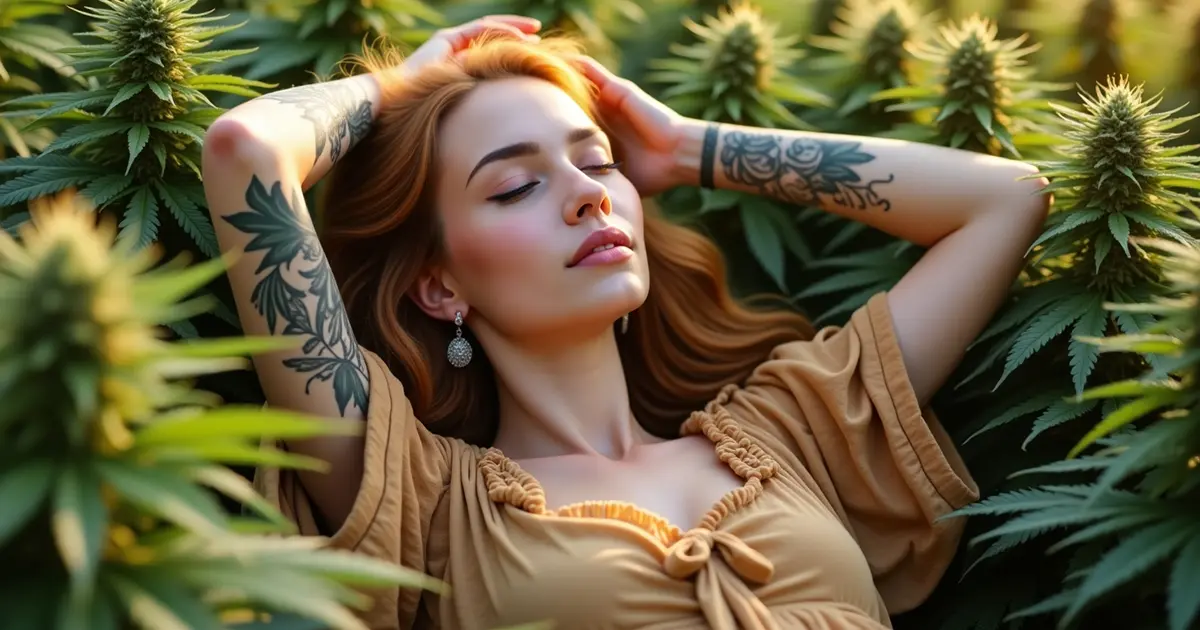Cannabis
The Best Weed Strains for Relaxation and Stress Relief in Canada (2025 Guide)
In today’s demanding world, relaxation has shifted from luxury to necessity. Between constant digital noise, workplace pressures, and everyday stress, many Canadians are turning to natural aids to help restore balance. Cannabis—particularly certain indica and hybrid strains—has become one of the most discussed and researched options for promoting calm and easing anxiety.
This comprehensive 2025 guide explores how cannabis can support relaxation, which strains are most effective for stress relief in Canada, and how to use them responsibly for long-term wellbeing.
Understanding How Cannabis Promotes Relaxation
The human body maintains balance through an internal network called the endocannabinoid system (ECS). This system influences mood, sleep, appetite, and stress response. When cannabinoids like THC (tetrahydrocannabinol) and CBD (cannabidiol) interact with ECS receptors, they help regulate neurotransmitters such as serotonin and GABA—both of which are linked to calm and emotional stability.
- THC produces euphoria, muscle relaxation, and enhanced sensory perception.
- CBD counteracts anxiety, reduces inflammation, and softens THC’s psychoactive edge.
Together, these compounds can create a sensation of mind-body harmony, sometimes described as a “weighted blanket” effect—deep calm without detachment.
The Role of Terpenes
Beyond cannabinoids, cannabis contains terpenes, aromatic molecules that shape a strain’s unique flavour and therapeutic effects. For relaxation, three terpenes stand out:
- Myrcene – Sedative and pain-relieving; abundant in mangoes and lemongrass.
- Linalool – Found in lavender; known for anti-anxiety and sleep-supporting qualities.
- Caryophyllene – Spicy, peppery aroma; interacts with CB2 receptors to reduce tension.
The combination of cannabinoids and terpenes produces the entourage effect, where multiple compounds amplify one another to deliver deeper stress relief than isolated THC or CBD alone.
What Makes a Cannabis Strain Relaxing?
Not every cannabis flower creates tranquillity. Relaxation depends on several interacting factors:
| Factor | Description | Why It Matters |
| THC/CBD Ratio | Balanced ratios (e.g., 1:1 or moderate THC) help calm without overwhelming psychoactivity. | Prevents anxiety or racing thoughts. |
| Genetic Lineage | Indica-dominant and certain hybrids tend to produce heavier body relaxation. | Ideal for evening or wind-down use. |
| Terpene Spectrum | Myrcene, Linalool, and Caryophyllene profiles. | These determine mood-enhancing aromas and body effects. |
| Consumption Method | Smoking, vaping, edibles, or oils release cannabinoids differently. | Influences the onset time and duration of calm. |
| Set and Setting | Environment and mindset when consuming. | Comfort and calm surroundings enhance relaxation. |
By paying attention to these factors, consumers can identify products that suit their stress-relief goals rather than relying solely on THC percentage.
Canada’s Most Relaxing Weed Strains in 2025
The following strains are available through licensed Canadian producers and dispensaries. Each is known for dependable, body-focused calm and gentle mental relief.
1. Granddaddy Purple (GDP) – Deep Classic Calm
THC: 20–25%
Flavour: Grape, berry, and earthy sweetness
Granddaddy Purple remains a gold standard among indica cannabis strains. It relaxes both body and mind, easing tension within minutes. The sedative nature makes it a staple for end-of-day decompression and sleep support.
2. Northern Lights – Legendary Serenity
THC: 18–22%
Flavour: Pine, spice, and fresh soil
This strain’s reputation spans decades for good reason. Northern Lights creates a dreamlike tranquillity that quiets repetitive thoughts while keeping the body comfortable and warm. It’s a reliable option for mild anxiety or restlessness.
3. Purple Kush – Night-Time Heaviness
THC: 22–25%
Flavour: Sweet grape with earthy spice
A potent, sedating indica, Purple Kush invites full-body relaxation and often leads to restorative sleep. The strain’s long-lasting effects make it popular among experienced users coping with physical tension or insomnia.
4. Bubba Kush – Mental Stillness and Grounding
THC: 20–23%
Flavour: Coffee, chocolate, and subtle earth tones
Bubba Kush offers a serene sense of focus reduction—the mental equivalent of turning down background noise. It’s excellent before meditation, journaling, or simply unwinding before bed.
5. Death Bubba – The Heavyweight Sleeper
THC: 25–27%
Flavour: Pungent pine and musk
Originating in British Columbia, Death Bubba is among the strongest indicas on the market. It delivers a wave of euphoria followed by profound drowsiness, making it best suited for seasoned consumers.
6. Ice Cream Cake – Sweet, Balanced Calm
THC: 20–25%
Flavour: Vanilla, creamy dough
A modern hybrid beloved for its dessert aroma, Ice Cream Cake relaxes muscles while maintaining a cheerful mood. It’s a versatile strain that can ease mild anxiety without full sedation.
7. Pink Kush – Canada’s Tranquillity Icon
THC: 22–24%
Flavour: Floral, citrus, vanilla
Pink Kush combines the uplifting mental relief of hybrids with the soothing body high of pure indicas. It’s especially favoured across Canada for evening relaxation, migraine relief, and stress management.
8. Blueberry – Fruity Everyday Relief
THC: 17–20%
Flavour: Blueberry and cream
Blueberry’s balanced effects make it one of the most beginner-friendly strains for relaxation. It gently uplifts the mood while melting away tension, making it perfect for light users or daytime decompression.
Choosing the Right Relaxation Strain for You
Selecting a strain is a personal choice—your response depends on your body chemistry, tolerance, and desired outcome. Consider these steps before purchasing or consuming:
- Clarify your goal. Are you seeking sleep support, social anxiety reduction, or overall calm?
- Check cannabinoid content. Lower THC (under 20%) often feels smoother for beginners.
- Study terpene information. Myrcene-dominant strains relax muscles; linalool calms anxiety.
- Review lab data and product reviews. Choose licensed, third-party-tested sources.
- Experiment slowly. Start with small inhalations or low-dose edibles (2.5–5 mg THC).
Methods of Consumption
Different formats influence how quickly and how long relaxation lasts.
Inhalation (smoking or vaping): Rapid onset (5–10 minutes) with effects lasting 1–3 hours. Suitable for immediate relief after stressful days.
Cannabis Edibles: Slower onset (30–90 minutes) but sustained calm for 6–8 hours. Ideal for bedtime or long-term relaxation.
Oils and capsules: Discreet, smoke-free, and easy to dose consistently. Effects develop gradually but last longer than inhaled products.
Topicals: Applied directly to the skin, they don’t cause intoxication but may relieve localized tension or inflammation.
Creating the Ideal Setting for Relaxation
The environment strongly shapes the effects of cannabis. To enhance calm:
- Dim the lighting and reduce screen exposure.
- Play low-tempo or ambient music.
- Pair with breathwork or mindfulness exercises.
- Keep hydration nearby.
- Journal or meditate once the effects have settled to achieve mental clarity.
Simple rituals—such as brewing herbal tea or stretching before consumption—can heighten relaxation and signal to the body that it’s time to rest.
Health and Safety Guidelines
While cannabis is legal for adult use across Canada, responsible consumption remains essential.
- Know your limits. Overuse can increase tolerance or cause grogginess.
- Avoid combining with alcohol or sedatives. Interactions can intensify impairment.
- Do not drive or operate machinery. Wait several hours after use, especially with high-THC strains.
- Secure storage. Keep cannabis in sealed, child-proof containers.
- Consult a healthcare professional if you take prescription medications or have anxiety disorders, heart conditions, or respiratory concerns.
For medical guidance, Canadians can access healthcare practitioners authorized under the Cannabis Act to provide personalized dosing advice.
Alternative or Complementary Relaxation Approaches
While cannabis may be effective for stress relief, combining it with lifestyle adjustments enhances results.
- Sleep hygiene: Maintain a consistent bedtime and reduce blue-light exposure.
- Exercise: Low-intensity activities, such as yoga or walking, increase natural endocannabinoid production.
- Nutrition: Omega-3 fatty acids support ECS receptor function.
- Mindfulness: Practices, such as deep breathing or progressive muscle relaxation, can lower cortisol levels.
A balanced approach—pairing responsible cannabis use with healthy daily habits—creates more sustainable calm than relying on THC alone.
The Evolving Science of Relaxation and Cannabis
Recent Canadian research is expanding the understanding of how cannabinoids influence mental health. Studies published in 2024 through Health Canada found that moderate cannabis use (below 20% THC) may temporarily reduce self-reported anxiety and improve sleep latency for adults with mild insomnia.
However, long-term overuse or dependency can have the opposite effect. Therefore, experts emphasize moderation, rotation of strains, and tolerance breaks. Continued legalization and standardized testing in Canada are helping ensure safer, more predictable experiences for consumers.
Frequently Asked Questions
Q1: Can cannabis replace traditional stress-relief methods?
Not entirely. While cannabis may provide temporary calm, it works best alongside mindfulness, exercise, and proper rest.
Q2: How long do relaxation effects last?
Inhaled products typically last 2–3 hours, while edibles may last up to 8 hours, depending on the dose and individual metabolism.
Q3: Is CBD-dominant cannabis better for anxiety?
Many people find CBD strains beneficial for daytime relaxation because they reduce anxiety without intoxication.
Q4: Are indicas always better than sativa cannabis strains for stress relief?
Generally, yes, but hybrid cannabis strains can blend uplifting mental effects with soothing body relaxation. Focus on terpene composition, not just genetics.
Q5: Can frequent use reduce cannabis’s relaxing impact?
Yes. Over time, the body may develop tolerance. Taking periodic breaks helps restore sensitivity and maintain effectiveness.
Final Thoughts
Relaxation supports every dimension of well-being. Cannabis, when chosen wisely and sourced responsibly, offers a natural route to serenity. Strains like Northern Lights or Pink Kush have stood the test of time, while newcomers such as Ice Cream Cake bring modern nuance to classic calm.
Above all, prioritize safety and quality. Buying from Bulk Weed Canada or other licensed Canadian cannabis dispensaries ensures tested, contaminant-free products and transparent potency data. Combined with mindful routines and balanced living, cannabis can be a gentle ally in achieving the rest and relief everybody deserves.
References & Credible Sources
- Government of Canada. (2021, March 11). Cannabis and your health. Available at: https://www.canada.ca/en/services/health/campaigns/cannabis/health-effects.html
- Canadian Centre on Substance Use and Addiction. (2022, April). Knowing Your Limits with Cannabis. Available at: https://www.ccsa.ca/sites/default/files/2022-04/CCSA-Knowing-Your-Limits-with-Cannabis-Guide-2022-en.pdf
- E Hoch, et. al. (2024, Sep 19). Cannabis, cannabinoids and health: a review of evidence on risks and medical benefits. Available at: https://pmc.ncbi.nlm.nih.gov/articles/PMC11910417/
- Health Canada. (2024, December 24). Canadian Cannabis Survey 2024: Summary. Available at: https://www.canada.ca/en/health-canada/services/drugs-medication/cannabis/research-data/canadian-cannabis-survey-2024-summary.html



